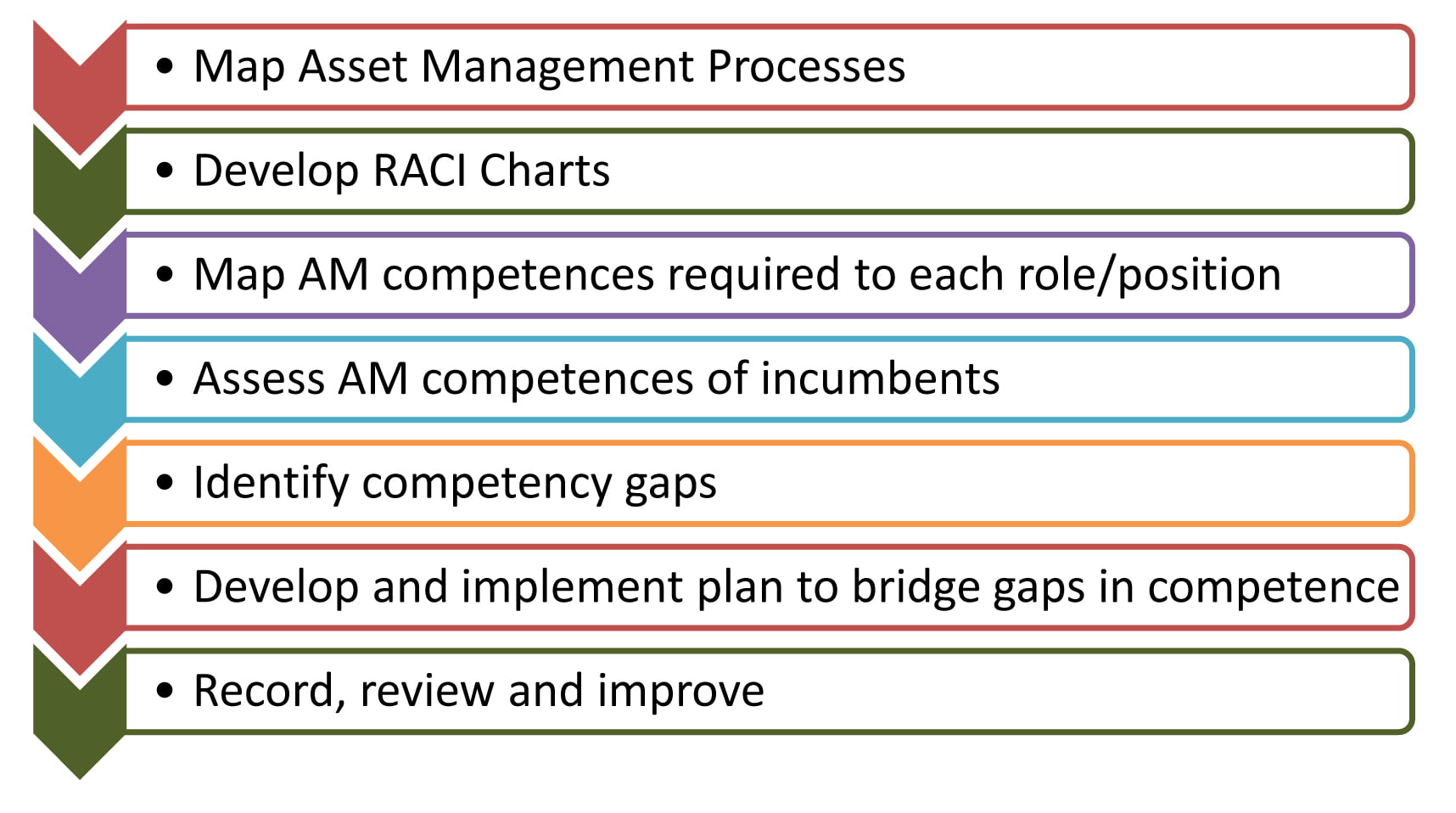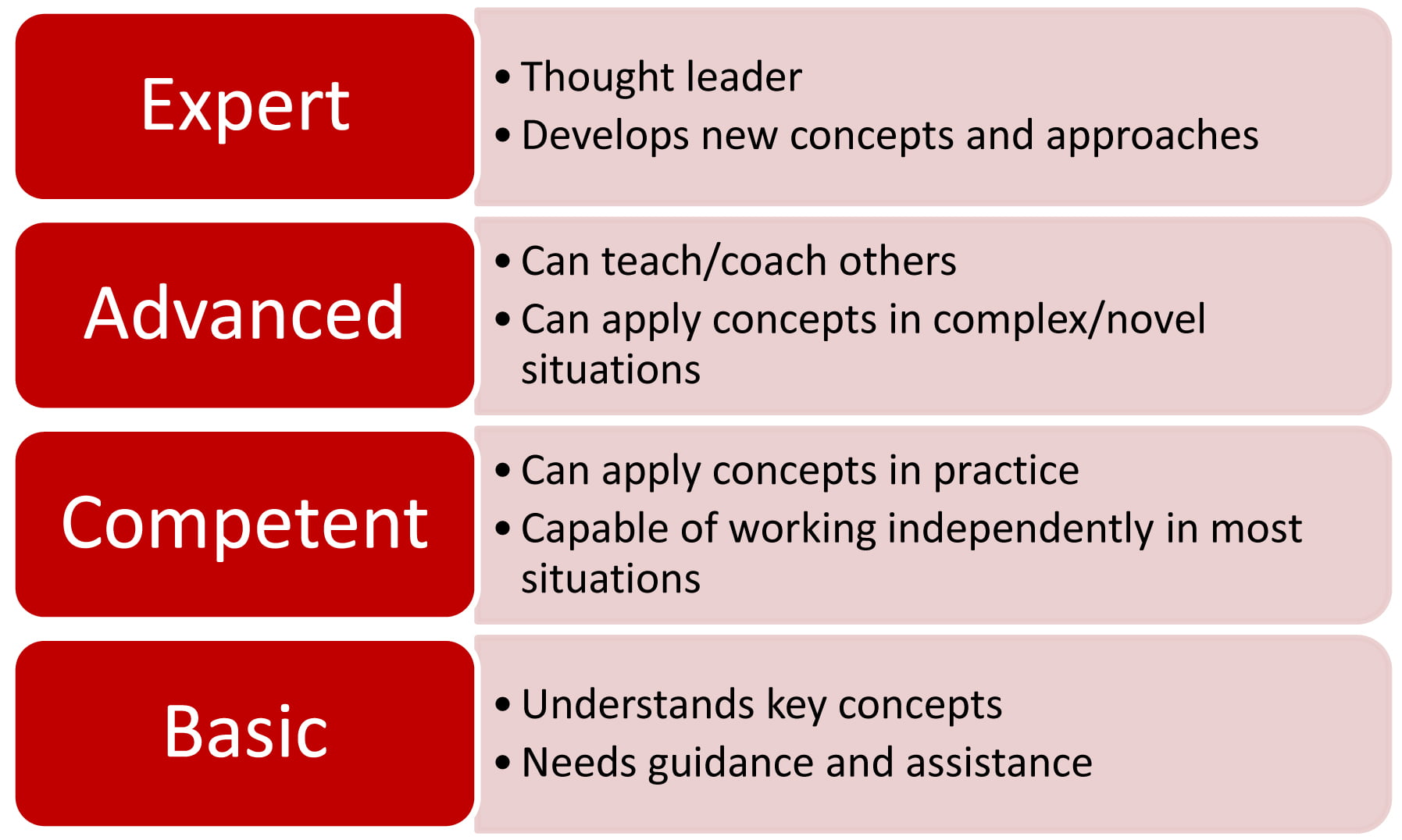So far in this series we have tackled the key requirements for successfully implementing ISO 55000 relating to documentation and management processes. Now we turn our attention to ISO 55001’s requirements in terms of asset management competence.
This is the ninth in a series of 13 articles on Implementing ISO 55000.
Articles in this series
ISO 55001 and asset management competence
ISO 55001 contains a requirement for organisations to ensure that they:
- Understand the competences required of individuals involved in managing their assets and periodically review and update these
- Ensure that those individuals have the required competences
- Understand any competence gaps that exist, and have plans and processes in place for bridging those gaps, and
- Maintain adequate records to demonstrate that required competences are held.
These are fairly general requirements, and do not provide much guidance regarding how to go about ensuring that these are met. The intent of this article is to help to fill that gap.
We consider that the following framework is useful in providing guidance regarding the competences required.

We discussed the key Asset Management processes in the previous article in this series. The key steps in each of these processes should be mapped using standard Business Process mapping techniques, and for each of these steps, it should be determined who is Responsible for performing the activity, who is Accountable for ensuring that it is done, who needs to be Consulted as part of the activity, and who should be Informed of the outcome. This is typically done in a RACI chart. For more on RACI charts, see here. Doing this then allows you to consolidate all of the Asset Management activities that are performed by each role or position, which then makes it easier for you to identify the competences required by each role in order to successfully perform that activity.
What asset management competences are required?
If you are looking for a starting point to assist you to identify the competences required for each role, there are two possible sources. The first of these is the Institute of Asset Management (IAM) Competence Framework. Initially developed to align with the requirements of PAS 55, this was updated following the release of ISO 55001:2014 to ensure that it aligned with the terminology contained within that document. The framework is available from https://theiam.org/CF, and is freely available to download if you first register as an affiliate of the IAM (which is free of charge).
The framework is based around seven key Asset Management “roles”, specifically:
- Policy development
- Strategy development
- Asset management planning
- Implement asset management plans
- Asset management capability development
- Risk management and performance improvement
- Asset knowledge management
It then assigns one or more “competence units” to each role. There are 27 competence units in total, and these have titles such as:
- Develop the AM strategy
- Create and acquire assets
- etc.
Each of these competence units are then broken down further into 153 elements of competence which provide more detailed guidance, and have titles such as:
- Develop key strategies for the overall system, asset portfolios and/or asset groups that support strategic aims and objectives
- Develop (asset) design specifications to achieve optimum customer, business and life-cycle requirements
The IAM framework outlines the generic knowledge and understanding requirements associated with each role, and forms the foundation on which the IAM’s Endorsed Trainer scheme is based. It also has been used to shape the requirements for achievement of IAM’s Certificate and Diploma in Asset Management. In doing so, it provides a very useful contribution allowing you to better understand the Asset Management competences that may be required in your organisation.
A potential second source of Asset Management competences is the list of competences developed by the Asset Management Council in Australia. This lists 243 individual competences, but as this list of competences was developed primarily to assist with their individual certification scheme (e.g. Certified Practitioner in Asset Management – CPAM) rather than to assist organisations to identify the Asset Management competences that they require, it is not quite as well classified as the IAM framework and therefore will need a bit more work to make effective use of it. You can gain access to the list of competences at https://www.amcouncil.com.au/certification/certification_competency_tree.aspx.
In practice, it is highly unlikely that the roles and position descriptions within your organisation map neatly to the generic roles contained within the IAM Competences Framework. For you to make effective use of the IAM framework it will be necessary to map each of the 27 competence units (and in some cases even the 153 individual competence elements) to each specific position in your organisation’s structure that is involved in managing your assets. If you are using the AM Council list of competences, you will also need to map these to the roles and positions in your organisation. To perform this activity, we would suggest that you use the process maps and RACI charts discussed earlier in this article to identify the competences required, but in the absence of these, then you may be able to work directly from the position descriptions for each role involved in Asset Management. This assumes, of course, that your organisation structure is clearly documented, and that the position descriptions for all asset management related roles in your organisation have been developed and are up to date.
As the IAM competence requirements are still quite generic (and, to a certain extent so are the AM Council competences), it will also be important to identify other elements of competence that may be specific to your industry or organisation and ensure that these are also listed. Some of these competence elements may be required in order to ensure compliance with externally imposed legislation or regulations. For example in many industries, certain positions hold statutory roles and their incumbents are required to hold specific qualifications, have had specific experience and/or have passed specific examinations in order to comply with those statutory requirements. A few examples from Australian industry include:
- A requirement for those in charge of an operating minesite to, as a minimum, be conversant with the relevant mine safety legislation and accompanying regulations, the risk management approach and hazards relevant to the operation, and have management and leadership skills.
- A requirement for engineers in Queensland to be Registered Professional Engineers (RPEQ) in order to carry out professional engineering services. Registering as an RPEQ requires a discipline-specific competency assessment to be completed.
- Plant operators need to hold a license in order to operate a boiler, which in turn requires specific competences to be demonstrated.
These will need to be incorporated in the competence matrix that you develop for your organisation.
In addition, you may choose to specify the level of competence that is required for each competence element for each role in your organisation. It may be useful to think of competence as having four levels as illustrated below:

For example in relation to the development of Asset Management plans, for some roles all that may be required is that they have a basic understanding of what is needed in an Asset Management Plan and what an Asset Management Plan is used for so that they can contribute meaningful information for inclusion in that plan. Other roles may need to be Competent so that they can develop the plans, while others may need to be Advanced or Expert so that they can modify and improve the template used for documenting Asset Management Plans.
So you can see that developing a comprehensive view of all the competences that are required for effective Asset Management is not necessarily a simple or straightforward task. At this point, you may even be considering that it will be an overwhelmingly complex and time-consuming task. But it need not necessarily be the case. As with all decisions relating to Asset Management, in determining the scope and level of detail associated with mapping competences to roles you should consider:
- Risks – what are the risks to the business if certain roles/positions/activities are performed by people who are not competent? Focus on defining the competences required for those roles and activities that represent the greatest level of risk.
- Benefits – what are the potential benefits to the business if certain roles/ positions /activities are performed by people who are highly competent? Focus on defining the competences required for those roles and activities that may provide the greatest opportunity for business benefit.
- Costs – how long will it take and what will it cost to identify the competence requirements and assess current levels of competence for this role/position/activity. Perform this work only if the risks and/or benefits outweigh the costs.
Regardless of the level of detail that you go to in mapping roles to competences, however, you should be able to justify why you have chosen to go to that level of detail in terms of the above three considerations.
Identifying and mapping competences is a task that many Learning and Development professionals will be familiar with, and it is likely that they will take the lead in this area within your organisation. However, they will more than likely need help from suitably skilled and qualified Asset Management professionals to ensure that all of the Asset Management competences required are duly noted and properly documented.
All of this, however, only ensures that you understand the competences that you should have in place in your organisation. It does not address the question of how you assess whether those competences are actually in place.
Assessing asset management competence
At this point it is worth making sure that you understand what is meant by the term “competence”. Competence can be defined as being “the ability to do something successfully or efficiently”. In other words competence can only be demonstrated by actually doing something. Attending a course and understanding theories and concepts does not necessarily make you competent – you are only competent when you know how to, and can demonstrate that you can, apply these concepts and principles in practice. So attending a course and passing a theoretical exam, while it may be a necessary prerequisite on the pathway to competence, does not, of itself, mean that you are competent. For example, just because you have passed the theoretical test for your driver’s license does not necessarily mean that you know how to drive a car.
Competence can be considered as having the following four dimensions:
- Task Skills – the capacity to perform tasks to the required standard;
- Task Management Skills – the ability to plan and integrate a number of different tasks and achieve a work outcome;
- Contingency Management Skills – the ability to respond to irregularities, breakdowns and other unanticipated occurrences; and
- Job/Role Environment Skills – the capacity to deal with the responsibilities and expectations of the work environment, including working with others.
It is important, therefore, when assessing competence that all four of these dimensions are assessed.
In terms of the first of these bullet points above, demonstrating competence requires the achievement of an agreed benchmark standard when performing the task. It is important, therefore, that this standard is documented, as least as far as this is possible. Some larger organisations have defined their own standards for the performance of specific tasks. In other cases, you may need to rely on the standards that have been established as part of a recognised training course or qualification. The IAM competence standards unfortunately do not explicitly specify the level of performance that is expected.
In order to assess competence, it will be necessary for your organisation to collecting evidence and make judgements on whether competence has been achieved. The evidence could take several forms:
- Direct, for example:
- Observation of workplace performance,
- Oral questioning
- Demonstration of specific skills
- Indirect, for example:
- Completion of written tests or examinations
- Review/assessment of previous work undertaken
- Achievement of externally awarded qualifications/certification
- Supplementary, for example:
- References from previous employers
- Reports from Supervisors
- Work diary/log books
- Examples of reports or workbooks
In order to comply with the requirements of ISO 55001, your organisation will need to determine what and how much evidence is required to make the assessment judgement. However in making this determination, you should consider the following four “rules” of evidence.
The evidence should be:
- Valid
- It relates to the unit of competence being assessed
- It considers all four dimensions of competence (i.e. task skills, task management skills, contingency management skills and job/role environment skills discussed above)
- Sufficient
- It provides enough evidence to be able to adequately judge competence
- Current
- Is recent enough to show that the skills and knowledge are still able to be applied
- Authentic
- It should be provable that the work proffered as evidence is the individual’s own
Once the evidence requirements have been determined, then the next step is to develop and execute a plan for collection of the relevant evidence, including, where required, on-the-job assessment of work performance.
Identifying and bridging asset management competence gaps
Once the current level of Asset Management competence has been identified, this can be compared with the competences and level of competence required of the position. Appropriate actions can then be planned and taken to bridge any identified gaps. This will normally be done through standard Human Resources processes for Personal Development Planning, and may incorporate a combination of attendance at training courses, delivery of one-on-one training and coaching, or other personal development activities.
The suite of Asset Management training courses specified by the IAM (and which align with their Competence Framework) may be helpful in assisting to bridge the competence gaps that you have identified. There are a number of training organisations endorsed by the IAM to deliver these courses (including Assetivity). For more information, see our Asset Management Foundation Award course below.
Competence management and recording system
Finally, for effective competence management, a competence management and recording system should be in place to ensure that workforce competences are adequate to permit the organisation to achieve its asset management objectives (and overall organisational objectives). This system should include processes for:
- Ensuring that position descriptions are up-to-date, and that roles and responsibilities for each position are accurately described
- Ensuring that the competences required for each position/role are adequately described and periodically reviewed and updated.
- Assessing/judging the current level of competence (with respect to their job role) of each individual involved with Asset Management
- Ensuring that the competences currently held by all individuals are accurately recorded together with any training received
- Planning and delivery of programs to bridge identified gaps in competence, including identifying or designing and planning education programmes, training courses and other development activities.
- Recruitment of competent people
- Career planning for key individuals
- Succession planning for key positions/roles
- Periodically reviewing and continually improving all of the above elements
Conclusion
I hope that this article has given you some insights into the activities required in order to ensure that your organisation meets the Asset Management competence requirements contained within ISO 55001. Even if you are not planning to certify against the requirements of ISO 55001, the process and activities outlined in this article do represent good practice, and if these are not yet in place within your organisation, then you should consider how to incorporate these in your Asset Management improvement plan.
Looking for further training in ISO 55001 certification?
We offer a range of asset management courses, some of which specialise in ISO 55001 deliverables. If you are interested in reading more about our courses, you can do so by following the links below.
-
Product on sale
 Implementing an ISO 55001 Compliant Asset Management SystemOriginal price was: $2,275.00.$2,047.50Current price is: $2,047.50.
Implementing an ISO 55001 Compliant Asset Management SystemOriginal price was: $2,275.00.$2,047.50Current price is: $2,047.50. -
Product on sale
 Asset Management Foundation AwardOriginal price was: $1,195.00.$1,075.50Current price is: $1,075.50.
Asset Management Foundation AwardOriginal price was: $1,195.00.$1,075.50Current price is: $1,075.50.


